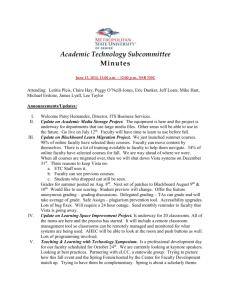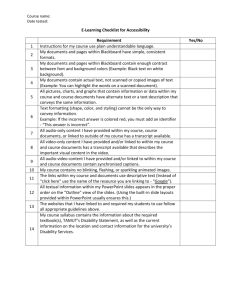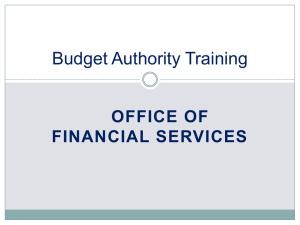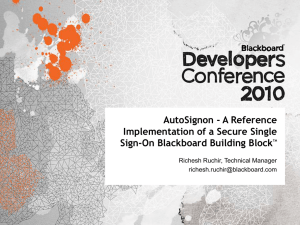The Online Education Experience Descriptor
advertisement
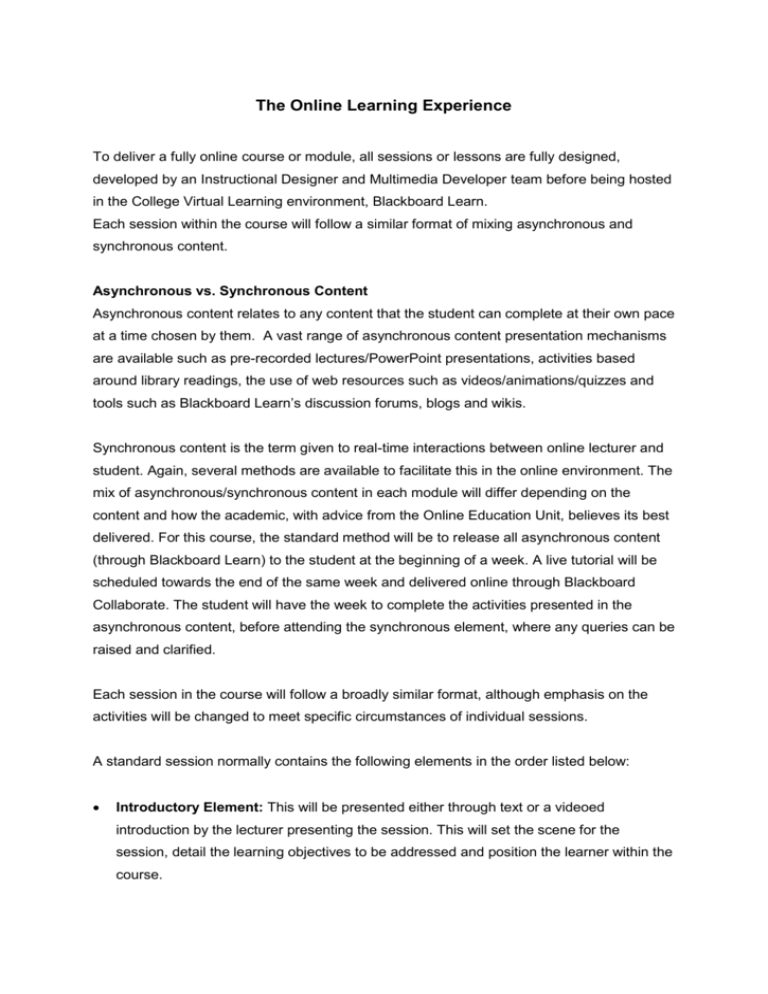
The Online Learning Experience To deliver a fully online course or module, all sessions or lessons are fully designed, developed by an Instructional Designer and Multimedia Developer team before being hosted in the College Virtual Learning environment, Blackboard Learn. Each session within the course will follow a similar format of mixing asynchronous and synchronous content. Asynchronous vs. Synchronous Content Asynchronous content relates to any content that the student can complete at their own pace at a time chosen by them. A vast range of asynchronous content presentation mechanisms are available such as pre-recorded lectures/PowerPoint presentations, activities based around library readings, the use of web resources such as videos/animations/quizzes and tools such as Blackboard Learn’s discussion forums, blogs and wikis. Synchronous content is the term given to real-time interactions between online lecturer and student. Again, several methods are available to facilitate this in the online environment. The mix of asynchronous/synchronous content in each module will differ depending on the content and how the academic, with advice from the Online Education Unit, believes its best delivered. For this course, the standard method will be to release all asynchronous content (through Blackboard Learn) to the student at the beginning of a week. A live tutorial will be scheduled towards the end of the same week and delivered online through Blackboard Collaborate. The student will have the week to complete the activities presented in the asynchronous content, before attending the synchronous element, where any queries can be raised and clarified. Each session in the course will follow a broadly similar format, although emphasis on the activities will be changed to meet specific circumstances of individual sessions. A standard session normally contains the following elements in the order listed below: Introductory Element: This will be presented either through text or a videoed introduction by the lecturer presenting the session. This will set the scene for the session, detail the learning objectives to be addressed and position the learner within the course. Prepare Element: These are online activities that the student needs to complete before studying the main presentations of the session. These activities will take the form of presession reading, a quiz to establish the students’ current knowledge, a video detailing the background to the content or any other relevant web resource etc. Often during this element of the session an academic problem will be posed that will be addressed in the main content of the session. Study Element: These are the didactic elements of the session, and most often take the form of a series of PowerPoint/Engage/Storyline presentations. Each presentation will address at least one learning objective. Apply/Reflect Element: These activities use the student’s knowledge gained in the previous elements of the session. The student will be asked to apply the content to their specific workplace, analyse and compare different concepts, reflect on their own learning and how they are developing new knowledge. A range of online tools, all available on Blackboard Learn, allow for effective documentation of these learning processes. For instance, discussion forums facilitate students to share and compare their knowledge and specific individual experience with classmates. Blogs, learning journals and wikis provide a reflective and supportive environment with the benefits of studying as part of a community, but without having to be in a physical classroom or even online at the same time as other students. Recall Element: This usually takes the form of an online quiz that allows students to assess how well they have achieved the lesson’s learning objectives. Each quiz question will address at least one of the session’s objectives; have carefully worded feedback that allows students to improve their learning should they provide wrong answers. The most basic question types such as “multiple choice” are most common, but there is a large range of possible questions available using Blackboard. This recall element is separate from the module’s summative assessment. Extend Element: Extra resources such as a reading list, relevant articles from the online library, videos on related topics will be recommended with information explaining their importance. While not compulsory parts of an activity that addresses a learning objective, these additional resources provide invaluable additional information to those students wishing to extend their learning on a subject. As such, students should not necessarily expect to complete all activities recommended in the extend phase, nor should the information gained from those additional sources be expected to appear in any formal assessment. Synchronous Element: At the end of the week, after all presentations and activities are completed, all students will attend a live synchronous event delivered via Blackboard Collaborate. This is usually scheduled for an hour, but the lecturer can ask students to complete some preparatory activity that will be the focus of the event. On completing this event, the student has completed the week’s activities for that session, and should be ready to begin a new session the following week. Online Student Support It is important that students understand the online learning environment in which they are studying. Support will be provided by the Online Education Unit to facilitate any student studying online. Several guides are available that help the online student familiarise themselves with the Online Experience. These include Getting Started: An Induction to Online Learning, Guides on Digital Literacy, Using Blackboard Learn and Collaborate, Studying online at Trinity College, How the Online Assignment Process Works and Trinity College Community. These will be made available on Blackboard Learn when the student first enrols on the course. At all stages of the course, the online student will have support of the academics and course coordinator. Students will access academics and relevant administration staff for assistance should the need arise. Academics can be asked content-related questions each week through the synchronous tutorials, where students will get real-time responses to any questions they might have. Alternatively, module-level and session-level discussion-forum will provide the opportunity for students to pose questions that all students and academics on the course can see and respond to. It is expected that academics periodically check on all discussion forum questions to ensure that all issues raised by the students are addressed. Students who prefer to keep their contact with academics and relevant administrative staff private can also contact them through the Blackboard communication system or via e-mail. Academic lecturers may provide further level of communication at their own discretion via Instant Messaging services, Skype details etc. Online Assessment There are two main forms of assessment, Formative and Summative, and both are catered for in the online environment. Formative Assessment: Formative assessment allows both tutors and students to assess how well the content is understood by the student. Quizzes using a range of different question types (multiple choice, ranking, drag and drop) are the most common method of formative assessment in online environments. For each question, students immediately receive correct feedback that reinforces their current understanding and indicates where they erred. These quizzes will provide guidance to the student with regard to the content they need to revise. Formative assessment will be used through other activities such as discussion forum posts, blog entries and through questioning in the Synchronous tutorial. Feedback can be provided on all activities through Blackboard Learn. Summative Assessment: The goal of summative assessment is to provide an opportunity for the student to prove the achievement of the module’s learning outcomes. A variety of online summative assessment methods are available for academics to employ in an online environment. These include End of Module Assignments, Oral presentations, group activities, continuous assignments throughout the module. All of these summative assessment formats will be catered for using Blackboard Learn and Blackboard Collaborate and are detailed in the table below. A range of different assessments are used by the lead academics throughout the course, with most using an end-of-module assignment. Summative Assessment Format Details End of module assignment Submitted online via blackboard Learn and graded online if preferred by the academic Oral presentation Students deliver their oral presentations via Blackboard Collaborate in front of the online class Group activities Blackboard Collaborate facilitates the breakup of classes into smaller groups which can be asked to work on/present to the class as a group. Online tools in Blackboard Learn such as the wiki tool can provide evidence of group activity that can be assessed by academics. Continuous assignments Assignments can be set at any time during the module, and can be catered for in a similar manner to the end of Module Assignment Asynchronous Activities The quality of the student’s efforts throughout the module can be assessed. The output of the student can be viewed in online mechanisms such as their learning journals or blogs. Online methods for conducting summative assessments

